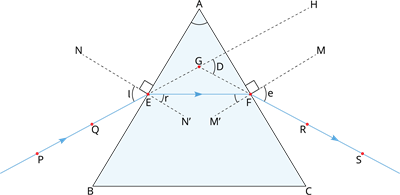PDF chapter test TRY NOW
Let us now do an activity to understand the refraction of light through a triangular glass prism.
Activity:
- Place a sheet of white paper using drawing pins on a drawing board.
- Locate a glass prism on the whitepaper in such a way that it rests on its triangular base. Sketch the outline of the prism by using a pencil.
- Sketch a straight line \(PE\) inclined to one of the refracting surfaces, consider \(AB\), of the prism.

Refraction of light through a glass prism
- Locate two pins, say at points \(P\) and \(Q\), on the line \(PE\) as shown in the figure.
- Look for the images of the pins, located at \(P\) and \(Q\), through the other surface \(AC\).
- Locate two more pins at points \(R\) and \(S\), such that the pins located at \(R\) and \(S\) and the images of the pins at \(P\) and \(Q\) rest on the same straight line.
- Remove the pins and the glass prism.
- The line PE coincides with the boundary of the prism at point \(E\) (see the figure). Similarly, connect and produce the points \(R\) and \(S\). Let these lines meet the prism boundary at \(E\) and \(F\), respectively. Connect \(E\) and \(F\).
- Sketch perpendiculars to the refracting surfaces of the prism \(AB\) and \(AC\) at points \(E\) and \(F\), respectively.
- As shown in the figure, mark the \(\angle i\), the \(\angle r\) and \(\angle e\).
From the figure, Pick and Place the labels of the ray diagram:
Answer variants:
Incident ray
Angle of refraction
Angle of the prism
Angle of deviation
Emergent ray
Refracted ray
Angle of incidence
Angle of emergence
1. \(PE\) -
2. \(EF\) -
3. \(FS\) -
4. \(\angle A\) -
5. \(\angle i\) -
6. \(\angle r\) -
7. \(\angle e\) -
8. \(\angle D\) -
The angle between the and the is called angle of deviation.
